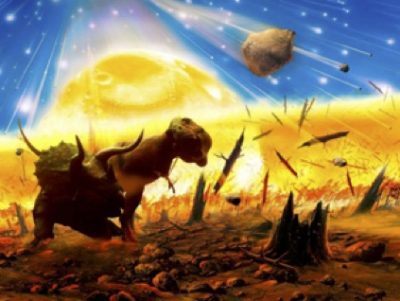
Mass extinctions get portrayed as single events of death and destruction. Does this portrayal obscure the hallmarks of extinction that are kicking into overdrive during the Anthropocene?
It has been over 30 years since the publication of Luis Alvarez’s groundbreaking paper in Science on the asteroid that impacted Earth 66 million years ago. Out of the pantheon of Earth history-focused scientific literature, this paper is a top contender for most popularized. You don’t have to look hard to find paleo-art of moon-sized objects impacting the Earth as Dinosaurs stand idly by, numbly staring damnation in the face or roaring impotently at the space rock.
I was reminded of how well-known Alvarez’s impact hypothesis is now during a recent lecture, when a student asked how likely it is that another extinction event will happen to us? Other students’ responses about asteroids “completely taking out” all life on Earth, shows the connection that students make: mass extinctions arrive to Earth via asteroid.
In the scientific literature, there is still an active debate whether the “Terrible Day Hypothesis” fully hits the mark. Some evidence suggests that life was indeed thriving up until the asteroid struck, while others suggest that biotic stress was already rising during the last part of the Cretaceous, and that certain lineages were declining, with the asteroid serving as the final blow.
This debate is unlikely to be settled any time soon, but let’s consider for a moment whether the portrayal of mass extinctions happening in a single terrible day is particularly productive. Other Phanerozoic mass extinctions were not associated with asteroid impacts, and extinction durations are at least on the order of tens of thousands of years. Yet, the popular image of these extinctions occurring in a single terrible day persists, as evidenced by the increasing interest in the “Great Dying.”
If we were able to study Anthropocene rocks in the future, would a popular image emerge where one day life was thriving and the next, humans had killed everything? This is certainly what it would seem like, as the layers of rock representing the Anthropocene, whether you put the boundary at 50,000 or 50 years ago, would be a thin sliver. And many species would go missing as you traverse this sliver. But there is no apocalypse out my window. A more realistic view of mass extinctions would acknowledge that they are the effect of numerous biotic and abiotic factors, such as climate change, progressive habitat degradation, collapse of food-webs and symbiotic interactions, loss of genetic diversity and introduction of novel predators, competitors and pathogens. The terrible day is already here, no space rock needed.
Tammo Reichgelt, February 4, 2021